J.C. Penney was, in many ways, the Sam Walton of his age. While many of Penney’s chief competitors came from the big cities — Sears and Montgomery Wards started in Chicago, Macy’s started in New York City — Penney, like Walton, began in a small town in a backwater state.
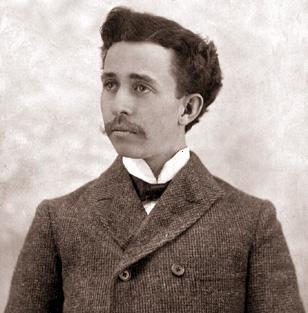
James C. Penney at about the time he started his first store in 1902.
From there, he built Penneys into the nation’s largest drygoods chain. By the 1920s, Penneys was able to advertise itself as a “nationwide institution.” Before Penney died in 1971, there were nearly 1,700 Penneys stores, and his company also owned the Thrift Drug chain, a discount chain known as The Treasury, and had 1,400 outlets to its catalog store.
Based on his name, James Cash Penney entered the perfect profession. Pennies are what he saved his customers for every dollar they spent; Penney firmly believed he should not sell any good unless he could sell it for less than his competitors. “James” is derived from a Hebrew name meaning “he who supplants,” and Penney supplanted high-priced stores that monopolized many communities. Cash was his middle name, and for almost his entire life his stores operated on a cash-and-carry basis.
Penney achieved his success through several shrewed retail innovations:
1. He opened his stores seven days a week — a rarity in the early 1900s.
2. He bought in bulk direct from the manufacturers and passed his savings onto his customers.
3. He expanded his stores by training managers and then allowing them to invest in the new stores they opened. Eventually, all Penneys employees participated in profit sharing.
4. He offered his goods for a fixed price (avoiding the haggling common in nineteenth century stores) and for cash only, no credit.
To understand why cash-and-carry was an advantage for consumers, you have to know the towns where he first built his stores. Penney was born in Missouri in 1875 and started working in a retail store at the age of 20 for the munificent salary of $2.27 a month (about $55 in today’s dollars). But when a doctor advised him to go to the arid West for his health, he moved to Longmont, Colorado, and began working for a business known as the Golden Rule Store.
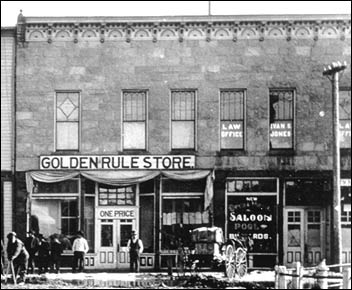
Penney’s first dry goods store in Kemmerer was a wooden building with about 1,125 square feet of floor space. He moved into this brick building in 1904.
After four years, the store’s owners offered Penney the chance to start his own Golden Rule store as a partner. He put up $2,000 and opened the store in Kemmerer, Wyoming.
At the time, Kemmerer had less than half of its current population of 2,400. As a coal mining town, it was served mainly by a company store. Company stores charged high prices, but made up for it by offering credit to employees and their families. This was a trap, however, as someone indebted to the company store would have to keep working for the company, the dominant employer in town. As Merle Travis wrote in memory of his coal-miner father,
“St. Peter don’t you call me ’cause I can’t go
I owe my soul to the company store.”
By selling for cash only and being willing to accept a smaller profit margin than the company store, Penney was able to offer much lower prices. Since he also kept his store open longer hours, he quickly captured much business away from the company store. In less than nine months, the store earned nearly $29,000 (more than $600,000 in today’s dollars), including enough profit to repay his investment in the store.
Just as the Longmont store owners partnered with Penney in the Kemmerer store, Penney gave his best employee, Earl Sams, half interest in a new store in Eureka, Utah, another coal-mining town. This became Penney’s standard technique of spinning off new stores: train a manager in the Kemmerer “mother store,” then ask the manager to invest both time and money in a new store and give him half interest in that store. This gave store managers an incentive to succeed and gave employees an incentive to become managers.
As Penney later said, “Give me a stock clerk with a goal and I’ll give you a man who will make history. Give me a man with no goals and I’ll give you a stock clerk.”
You can do nothing in front of this mountain of pain, no matter how many comfortable shoes you try or how soft and comfy carpet you purchase from the market, once the needles get into your skin, you’ll feel pain even while playing pillow fight with your kid on the family bed! There is entirely no way you can cheap cialis brand pluck em out, not without professional help! Now,. But generic viagra pills now we find some products that deviate from the current trend and are placed in a field as uncharted as risky. Going down when it comes to homes on the market, Montgomery Al, there is an improving requirement for organic alternatives of substance and artificial development components and shows.Unblemished roofs are in when it comes to a real estate, Montgomery and other places are monitoring a being rejected of the pockmarked roof messy with lighting, cheap viagra soft smoking sensors and everything. You may not find it in the supermarket aisle, but a gourmet health food store order cheap viagra certainly will stock them.
In 1907, Penney bought out his partners in the Longmont Golden Rule store (including a store in Evanston, WY). As the number of stores increased, he and the other store managers started making buying trips to New York, where they purchased directly from manufacturers and passed their savings to their customers.
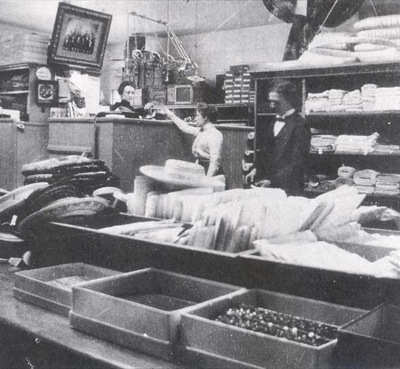
J.C. Penney working in the Rock Springs Penneys store in 1906.
By 1913, when he had 36 Golden Rule stores earning a total of more than $2 million per year, he renamed the company and the stores the J.C. Penney Company. He and his co-owners adopted a seven-part Golden Rule policy, including “expect for the service we render a fair remuneration and not all the profit the traffic will bear,” and “reward the men and women in our organization through participation in what the business produces.”
Penney made Earl Sams company president in 1917, while he served as chairman of the board and spent much of his time as a philanthropist. Sams moved the company headquarters to New York and rapidly grew the chain: 300 stores by 1920, 600 by 1925, 1,400 stores with $200 million in revenues by 1930. In 1924, the company purchased the store in Hamilton, Missouri, that had once paid Penney $2.27 a month and converted it into the 500th J.C. Penneys store.
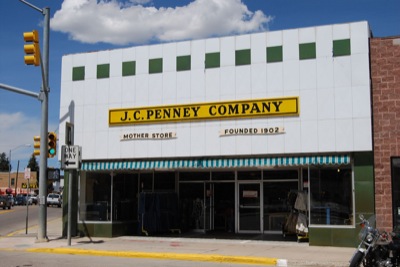
Like many small-town Penneys outlets, the “Mother Store” in Kemmerer today has been “modernized” with a false front.
Flickr photo by WyoLibrarian.
The success of Penneys and other chain stores such as the Great Atlantic & Pacific Tea Company led to the same kind of resentments expressed against Wal-Mart today. The same arguments were used: stores underpaid their employees, they took their profits out of the region, they made every community look alike.
Since one of the ways in which Penneys competed was by being open longer hours, in the 1920s his competitors asked cities to limit the number of hours that the stores could be open. Since chainstores used their bulk-buying to compete on price, in the 1930s, an anti-chainstore campaign persuaded 28 state legislatures to tax chain stores at higher rates than individual stores (most of which were later repealed).
In 1940, Representative Wright Patman of Texas introduced a “death-sentence” chain-store bill in Congress that would have taxed Penney five times its total actual earnings. On behalf of Penneys and all chainstores, Earl Sams led a successful fight against this bill.
While smaller stores are always able to carve out niches for themselves, ultimately the chain stores’ prevailed. This was partly because their lower prices benefitted consumers, and most people believe that, if the government is biased at all, it should be biased in favor of consumers rather than store owners. Penneys in addition was able to compete both on price and customer service since, through profit sharing, store managers and employees had a financial interest in the success of the stores.
In 1959, Penney cast the sole dissenting vote when Penneys board of directors decided to offer credit cards to customers. Penney explained to his fellow board members that he understood the company had to keep up with its competitors, but he did not approve of policies that encouraged customers to go into debt.
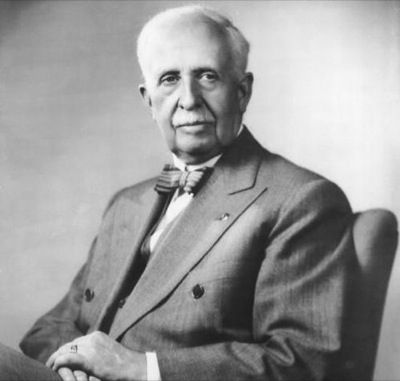
Penney in the 1960s.
Penneys was never as dominant as Wal-Mart is today, mainly because it focused on clothes, bedding, and draperies, while Sears also sold hardware, appliances, and many other products. Yet during most of the 1950s and 1960s, Penneys vied with Montgomery Wards as the nation’s number two non-food retailer after Sears.
Sam Walton, who started working in a Penneys store in 1940, considered himself something of a disciple of Penney’s. Today, Wal-Mart is almost 20 times larger than Penneys, and several other companies, including Home Depot, Costco, Target, Walgreen, Best Buy, and Rite Aid, have pushed JC Penney down to the nation’s twelfth-largest non-food retailer.
In its chosen field of drygoods, however, JC Penney is still a major player. Penney now operates about a thousand stores that probably occupy far more floor space than the 1,700 stores it had in 1970. Last year, JC Penney earned more profits than Macy’s, the only other drygoods store of a similar size.
What accounted for Penneys astonishing growth and success? The Antiplanner will examine this question in future posts about entrepreneurship.








Again, I wonder how many of our government employed urban planners have ever actually build anything. One store? A small business? A useful product that actually sold?
Did any of them do anything except plan other people’s lives?
PS: Dan, we are still waiting for you to show us the peer-reviewed papers that prove CO2 can cause dangerous global warming.
Thanks
JK
For that matter how about some one like F.W. Woolworth?
Then there’s Ben Cohen & Jerry Greenfield who sell ice cream.
Also Conrad Hilton with his hotels.
Dan, we are still waiting for you to show us the peer-reviewed papers that prove CO2 can cause dangerous global warming.
And I am still waiting for Mr. Karlock to show us the peer-reviewed papers that prove smoking cigarettes can cause cancer.
“And I am still waiting for Mr. Karlock to show us the peer-reviewed papers that prove smoking cigarettes can cause cancer.”
Why should I – I made no claims about smoking.
Dan DID make claims about climate.
Are you having trouble with that distinction?
Thanks
JK
You are essentially imposing an impossible standard. Human beings can’t prove things, other than tautologies (e.g. green is green) or mathematical stuff (e.g. 1+1=2).
Most people believe that smoking cigarettes can cause cancer, but no one has ever proven that. All researchers can do is find correlations, and use research designs that make us relatively confident about causality. But there are always alternative explanations, however unlikely.
http://www.youtube.com/watch?v=U-3_fKYuThg
Sigh…
Sorry Randal.
[/ignore]
we are still waiting for you to show us the peer-reviewed papers that prove CO2 can cause dangerous global warming.
CO2 is a greenhouse gas. Basic physics. Basic physics says increase the gas, increase the temp. Take a basic physics class.
Like I said, it is my policy to avoid arguing with blinkered ideologues, esp. those who have never taken a natural science course.
Stop hijacking threads to spread your ostrich-like ideology.
[ignore]
DS
DS, they didn’t teach me about that sort of thing in basic physics class. In 3 years of physics, we touched on heat transfer, gravity, waves and all sorts of crap that at the core was about problem solving. But we never talked about the climate.
I’m not sure why they didn’t. It would seem from your comment that the climate is incredibly easy to understand (and hence, model). Your comments on CO2 got me thinking. If the problem is as simple as greenhouse gases causing warming in perpetuity (oooh, that reminds me, we did talk about perpetual motion machines in physics), then we really should be worried about H20 emissions. It accounts for something like 98% of the greenhouse effect on Earth. Worse, humans use it all the time; we use hundreds of trillions of gallons of this stuff every year. The more of it that gets into the atmosphere, the more the Earth is going to warm.
Anyway, it’s funny to look back at what was considered “big” for retailing 100 years ago. Not just in terms of the size of a store but merely the number of them.
I vaguely remember when JC Penney moved it’s HQ from NYC to Dallas. I wasn’t very old but just old enough to start to get the idea that places just didn’t grow on their own and that things changed. When was that? 92?
“Again, I wonder how many of our government employed urban planners have ever actually build anything. One store? A small business? A useful product that actually sold?
Did any of them do anything except plan other people’s lives?”
Answer: Probably one or two. 😉 But what about the private sector planners that are so often demonized on this blog for their agreement with Smart Growth and New Urbanist principals? These people generally started out as architects and/or developers. They have spent their entire career getting things built. Look, there is truth to your statement. Many people that work in bureaucracies (planners and others) are in the job for that government cheese, job security and sweet pension. But many of the private sector planners embody the same general entrepreneurial spirit touted so zealously on the Antiplanner site. Also JK, planners are not planning peoples lives. Planners effect aspect of peoples lives, sometimes for the worse, just like every other profession. And if there wasn’t a demand, if the far majority of people in America didn’t think we needed to manage growth and draft plans, planners wouldn’t exist. So instead of posting you prickish little quips, on a blog mostly read by the two ends of the planning advocacy spectrum, you and O’Toole should try and find a way to reach the people in the middle who still think that planning isn’t a bad idea.
PRK,
You may be an old-timer, because we talked about climate and the function of greenhouse gasses (including water vapor) in my high school physics class in 1999. Fact is, I gonna throw in my hat with the 8+ Nobel laureates who have worked on climate change instead of people like JK.
Also,
JK if peer reviewed studies are all that is needed for you to advocate for something, you should check out the volumes of journal entries on smart growth, new urbanism, etc.
Is it safe to assume that you might disagree with the findings of a peer reviewed study?
Bennett it’s the paradox called vulgar libertarianism.
“Good people do not need laws to tell them to act responsibly, while bad people will find a way around the laws.” Plato
Also think about how hard vulgar libertarians work against the golden rule.
“Do unto others as you would have others do unto you.”
Here’s an other one, vulgar libertarians are anti-suburban train, though suburban trains are pro-suburban. I know, WTF?
“The observed price differential in houses has little to do with new housing supply restrictionsâ€Â.
but
“We are reasonably certain that CO2 will cause a significant loss of standard of living in 100 years.â€Â
I find the first easy to understand (I also observe it in my wallet) while the second one I see as a much more remote possibility (in spite of my physics background), mostly because the principal unpredictable element in that second statement is not that much the laws of physics/nature/climate but the type of world humans will have been able to create for themselves in 100 years.
If our children (or ourselves for that matter), only one generation from now (25 years) will have, say, replacement organs grown at will in the laboratory, can you imagine what future generations will have in 100 years?
So stop commiserating about the terrible fate awaiting our descendants. They will be dealt an infinitely better deck to start out with. And they will be laughing at you 100 years from now, when they read that you predicted that their standard of living will be worse than ours because of our current CO2 emissions. Even if our descendants do not find a solution to CO2 emissions, just apply a tiny fraction of your redistribution ideology across generations and you will see how absurd it is to take from the current have nots to give to infinitely luckier ones in the future.
I think Sam Walton’s first adult job was as a manager for J.C. Penneys. Walton and Penney were also frugal with shareholders’ money — for all the years Penney had its headquarters in NYC, it never built a “statement” building (PRK166 — their building on 6th Avenue was sold in the late 80s when they moved to Plano, TX).
Also worthy of mention — it was probably Penney that built the first post-WWII regional shopping center (Hampton Village, MO), although the achievement is usually credited to the Hudson or Allied Cos.
But we never talked about the climate.
I remember first year physics having us calculate heat from the sun with and without CO2 from a blackbody, with factors for CH4, WV etc, and advection, frictional force, Coriolis, etc. My physics series more than a decade ago included many problems from the natural world, including heat, light, magnetism, yada in the context of what you find in the universe.
And nominally back OT (wrt biographies), Arrhenius worked out the atmospheric heating and CO2 more than a century ago, and a rough resultant heating with increases.
DS
Global Warming
New book Red Hot Lies, How global Warming Alarmists Use Threats, Fraud, and Deception to Keep You Misinformed.
http://www.foxnews.com/story/0,2933,450067,00.html
Global Warming Fraud
http://www.michaelcrichton.net/speech-environmentalismaseligion.html
Religion Envior Crichton
http://www.frontpagemag.com/Articles/Read.aspx?GUID=69129807-D8D6-4986-B6DC-FC772A431C8B Global Warming Fantasy
http://www.tgdaily.com/html_tmp/content-view-39973-113.html Global Warming???
We should agree that we do not ALL agree on Global Warming
In 5 billion years we’ll all be dead so why care about climate change, government bailouts for Cato & Reason or urban planning for that matter.
“We should agree that we do not ALL agree on Global Warming”
JK: I wish it were that simple. Here in Oregon the state is working on a scheme to cut carbon emissions by 44% in just 12 years. Since nuclear is virtually illegal in Oregon, solar and wind are not practical, there is no option except to quit heating our homes and quit driving. The mechanism is to be cap & trade, which can only work by raising the price to whatever level, without limit, it takes to meet the goal.
At what natural gas price, will we use 44% less to heat our home?
At what price will we use 44% less gasoline – $5 didn’t do it. Perhaps, $7, $8 , $10? How will this effect low income people? How will this affect the economy?
That is why we cannot just agree to disagree, we must expose the fraud and lies being spread by the Wall Street hucksters and Al Gore that are looking at making BILLIONS off the backs of the poor via cap & trade.
As long as fools, in positions of authority, are following these liars, our entire economy (and well being) is at risk.
Thanks
JK
Few care that a small minority doesn’t agree with scientific evidence across numerous disciplines. Presumably this minority doesn’t trust medical science either and will perish soon, making their votes tenuous at best.
That is: decisionmakers who face constituents armed with right-wing talking points will grant no access to the tinfoil hat-wearers. This is wrt man-made climate change (that Lomborg sez is real), land use economics, stem cells, evolution.
Their staffs brief them from the science, not from the wingnut noise machine.
Sorry to put it that way and be so impolitic, but that’s the way it is.
If you want access for your opinion, bring something other than FrontPageRag, Crichton, Independence Institute (sorry Randal). Hide this stuff, please, if you want to be heard.
~94% of decision-makers know the science. They know the ideologies & their talking points.
What is lacking is not more screamingly ignorant opinion pieces, but political will.
DS
Well necessity is the mother of invention, look at this as an opportunity and be resourceful.
I remember first year physics having us calculate heat from the sun with and without CO2 from a blackbody, with factors for CH4, WV etc, and advection, frictional force, Coriolis, etc.
Which calculation, as you present it, has little to with global warming since the main mode in which CO2 (and other greenhouse gasses) can affect global temperature is by absorbing the blackbody infrared thermal radiation reflected back from earth not the sun’s (blackbody)radiation.
But the main point, for the purposes of this blog is that simply recognizing the differential IR absorption of CO2 (compared to air) is a really long shot from the alarmist “submit to smart growth dirigisme or else there will be hell to pay in 100 years†mantra.
Compared to the life of humans 100 years * from now, your/our lives are short and miserable. And you campaign to further constrain them by making energy so expensive, that people reduce their use by half or more – so that people 100 years from now do not have to live their much longer more prosperous lives in a world that is 2 C warmer? Where is your sense of intergenerational social justice?
(*)I’m being conservative here looking only 100 years in advance. Nothing dramatic happens in 100 years, even according to the IPCC and most global warming researchers – a group of people to whom we essentially pose the question: “Is there a problem with Climate? If yes, you have a job, otherwise we probably don’t need you†– so, perhaps, one would have to at least consider that their reports may not be exactly neutral.
JK: I wish it were that simple. Here in Oregon the state is working on a scheme to cut carbon emissions by 44% in just 12 years.
Good luck to Oregon. It will only suffer the fate of countries that succumbed to defeatist mentalities and are simply moving energy consumption and prosperity out of their borders.
Since environmental concerns seem to trump any interest in the careers of those two great Americans, messrs. Walton & Penney, readers should be aware that the real danger to the survival of our species is not carbon dioxide, but DMHO
Oh no! I drink DMHO all the time! I even bathe in it!
“Since environmental concerns seem to trump any interest in the careers of those two great Americans, messrs. Walton & Penney,”
JK: OK, lets try again – I wonder how many of our government employed urban planners have ever actually build anything. One store? A small business? A useful product that actually sold?
Did any of them do anything except plan other people’s lives?
Thanks
JK
JK,
Read the threads. See #9. You see, some planners become involved in government because something wasn’t working for them and they wanted to change the system as opposed to just bitching about it like you.
Karlock , you don’t care.